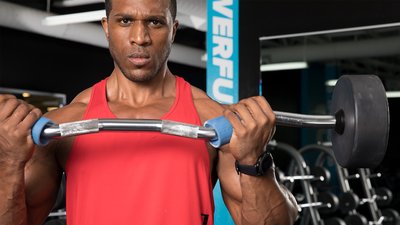Fat-grip (aka fat-bar) training has become extremely popular in recent years. It is mentioned regularly by pro bodybuilders and strength coaches as a "secret" for building strength and muscle, and building up your upper body's weak links. The only problem, until recently, was that few gyms stock thick bars or have thick pull-up bars. But now, for about $40, you can buy portable rubber grips, toss them in your gym bag, and take your grip and arms to the next level.
Count me among the believers in fat-grip training. I've seen the simple addition of a larger grip do pretty amazing things for strength and muscle gains in athletes, and they're an indispensable accessory in my gym.
Like anything, fat-grip training can be done right or wrong. Here are the most important things to keep in mind, and my favorite moves to use with thick grips.
Why Fat-Grip Training?
When you increase the thickness of a weight-training implement, the demand placed on the hands and arms increases significantly. You're forced to exert more muscular force to grip the barbell or dumbbell, which means greater mechanical tension in the muscles all the way up the kinetic chain.
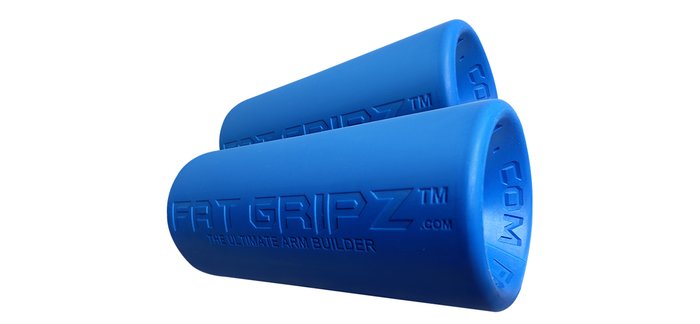
Don't believe me? Try this: Put your left hand on your right biceps, then make a fist with your right hand—as hard and fast as you can. What happened? Your biceps contracted nearly as hard as the muscles controlling your hand. This illustrates the major ways that fat grips will support strength and muscle gain by increasing mechanical tension in the arm muscles.
Fat-grip training can also increase your grip strength. Grip strength is often the key for unlocking hidden gains. Do you struggle with chin-ups, the single best back builder in existence? Grip strength is the most likely thing to help you. Do you drop your deadlift—the other best back builder—as you approach your max? A stronger grip allows you to lift more weight and really bear down on the bar, which builds more muscle and strength.
Don't just add grips to every heavy thing you do and expect it to work, though. Follow my five rules for getting the most out of fat-grip training, and you'll limit the risk and maximize the reward.
Rule 1. Limit Heavy Upper-Body Pulling Exercises
Compound exercises are the foundation for a good program because they build strength in more than one joint. But as every experienced lifter knows, it's easy to make a compound lift too stressful on our joints. Fat grips can definitely push you over that limit.
The chin-up is a perfect example. Chin-ups performed with fat grips can take elbow stress through the roof because the forearms have two-joint action, meaning that the forearms contract to both flex the elbow and to curl the wrist. Because it's doing these two jobs at once, the muscle can become quickly overwhelmed, potentially resulting in cramping and tearing.
For this reason, intensity on the following upper-body exercises should be kept low when using thick bars. Do them sparingly, and listen to your body. Yes, I've used these myself and trained others with them successfully, but as soon as we go too hard or too often, I get complaints of elbow pain and serious soreness. You don't want elbow tendinitis or a torn forearm muscle. Trust me—I've had both.
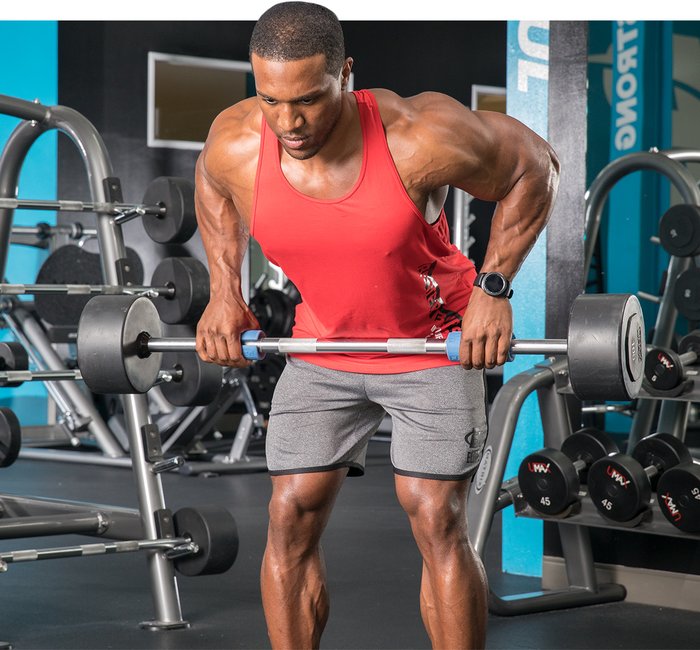
Moderate resistance only: 6 reps or higher
- Chin-ups or pull-ups
- Barbell rows, especially with a supinated (underhand) grip
- Heavy biceps curls
2. Go for High Reps or Finishers
Forearms respond well to high-rep sets. The high time under tension gives both forearms and upper arms that "full" look. And since high-intensity upper-body exercises can be dangerous because of the two-joint action, a safer approach is limiting weight on fat-grip exercises and focusing on higher reps and longer time under tension.
Here's how that can work in a simple one-two punch for the forearms and biceps:
- EZ-bar biceps curl: 3 sets of 8-12 reps, moderate weight
- Fat-grip EZ-bar biceps curl: 2-3 sets to failure, lighter weight
This combination will provide a great pump and cause the metabolic stress that helps break down muscles, forcing them to grow bigger.
3. Don't Rely On Them to Build Absolute Strength
When improving maximum strength is the goal of an exercise, such as in a 3-rep max deadlift, the intent is to move as much weight as possible. However, using fat grips on such efforts will reduce your performance by making your grip the weak link.
For instance, if you can deadlift 450 pounds, you might only be able to do 300 pounds using fat grips or a fat bar. If your goal is to increase your deadlift beyond 450, performing reps to failure at 300 won't cut it. Sure, your grip strength will probably improve, but your maximum strength in the deadlift won't. This is because many of the other muscles in question—the back, glutes, and hamstrings—will only be stimulated at 67 percent of their maximum output.
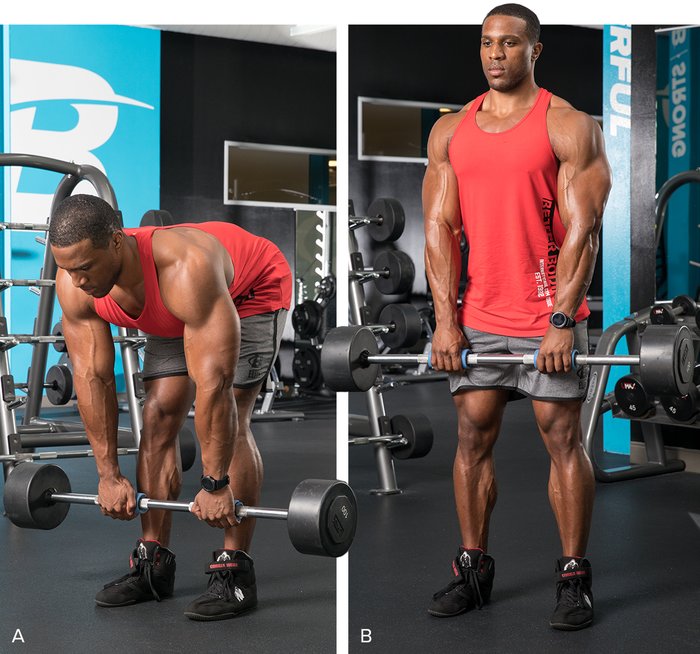
The cure here is to do standard bar work followed by fat-grip work:
- Deadlift low to moderate reps using regular bar
- Fat-grip deadlift holds or high-rep sets
If strength is your goal, this combination of endurance work and heavier-resistance work will lead to fantastic results.
4. Make it Part of a Balanced Grip Approach
Some lifters make it sound like fat grips are all you need to build otherworldly arm strength and size. But if you're really prioritizing these attributes, you need an overall approach that includes several elements.
Crushing-grip training: Think exercises such as rack holds, farmer's walks, grippers, or max-effort deadlifts. This builds maximum strength, which makes all other grip-related tasks easier.
Open-hand training: These areexercises in which the hands can't fully close around an object. Fat grip training and pinch-grip holds fall into this category. These build finger strength to a higher degree than the crushing grip.
Endurance and metabolic exercises: The fat-grip finishers above fit into this category. These stimulate muscle growth through progressive overload and metabolic stress. If you have both max-effort lifts and a strong pump in the muscle, you will get bigger and stronger.
Range of motion exercises: These are exercises like wrist curls, Zottman curls, and reverse curls. Most grip exercises require the lifter to simply hold an item while the wrist is held stable, but taking the wrist through the range of motion is also important to stimulating muscle growth.
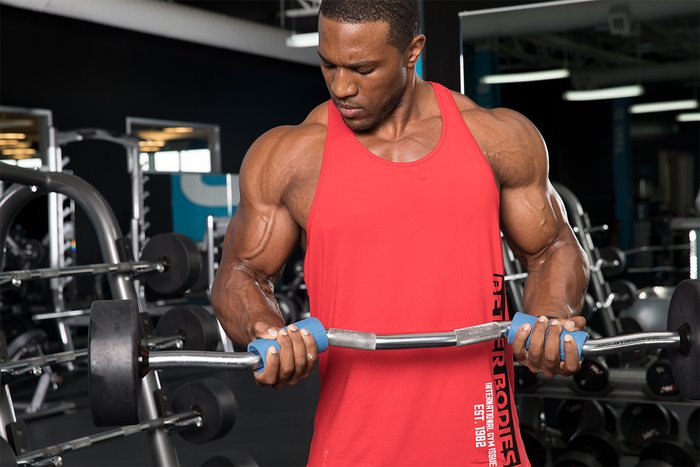
5. Match Your Goals
To get the most out of your fat-grip training, you need to be clear about why you're using them. Is it to develop bigger forearms and stronger hands? To develop bigger arms in general? To get stronger on your big lifts, such as the deadlift?
Your goals will help guide the best use of fat grips, so you're not wasting time. It will also keep you from resorting to the "throw them on everything and hope for the best" approach.
Coach Dan's Favorite Exercises
1. High-Rep Fat-Grip RDLs
High-rep Romanian deadlifts, in the 15-25 rep range, will help boost hamstring strength in a hurry for those looking to increase their squat or deadlift numbers. But because higher repetition sets require less weight, which in turn means less grip demand, adding fat grips helps ensure that all body parts involved are working hard. These should not be brutally heavy.
2. Offset Farmer's Carry
Varying grip training with offset holds is a great idea. When holding a heavier weight in one hand, the core is forced to work harder to keep the body upright.
Holding a 100-pound dumbbell in one hand with a 50-pound dumbbell in the other is one option. I prefer throwing a fat grip on the lighter dumbbell to even the score. That way, the heavy side naturally produces high grip demand and the thicker grip of the lighter dumbbell produces an equal, but different, challenge. Then switch sides, of course.
3. Fat-Grip Zottman Curl
Zottman curls do a great job of challenging both the biceps and the forearms. But the Zottman curl truly excels in that it hits the often-neglected forearm extensors on the way down. To build big forearms, we can't forget about the extensors. With fat grips for moderate to high reps, these will burn like crazy.
4. High-Rep Fat-Grip Barbell Row
The barbell row is excellent at bolstering the spinal erectors and building thicker lats so that you can support more weight when squatting and deadlifting. While in the bent-over position the back benefits greatly from time under tension, and adding in longer-rep sets takes advantage of this.
When going higher in repetitions weight must decrease. So to keep demand on your arms high, use a thick bar or fat grips and make it a race to see which tires first: your grip or your back.
5. Dumbbell Walking Lunges
Lunges are boring, but they're also incredibly hard, especially at heavy weights. One way to make light-weight lunges a bit more full-body is to add fat grips. This forces more tension to flow through your hands and arms as you take tedious lunge after lunge. You'll hate me while you do them, but you'll thank me later.
Back, legs, arms, abs, forearms…that's a lot of muscle groups to benefit from a single cheap accessory. Make this the year you go fat, and you won't regret it!

